Unit 2 Wildlife protection Listening and Speaking & Listening and Talking 课件(共31张PPT,内镶嵌视频和音频)
文档属性
| 名称 | Unit 2 Wildlife protection Listening and Speaking & Listening and Talking 课件(共31张PPT,内镶嵌视频和音频) |  | |
| 格式 | pptx | ||
| 文件大小 | 40.2MB | ||
| 资源类型 | 教案 | ||
| 版本资源 | 人教版(2019) | ||
| 科目 | 英语 | ||
| 更新时间 | 2024-04-05 16:19:01 | ||
图片预览

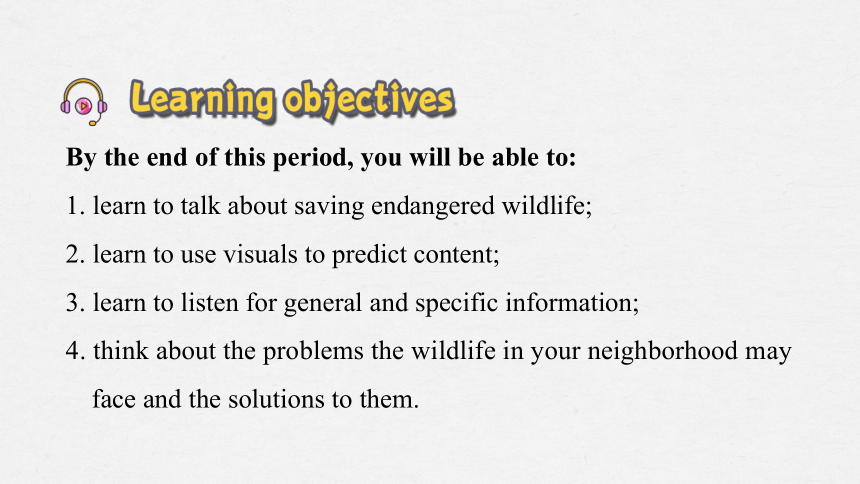
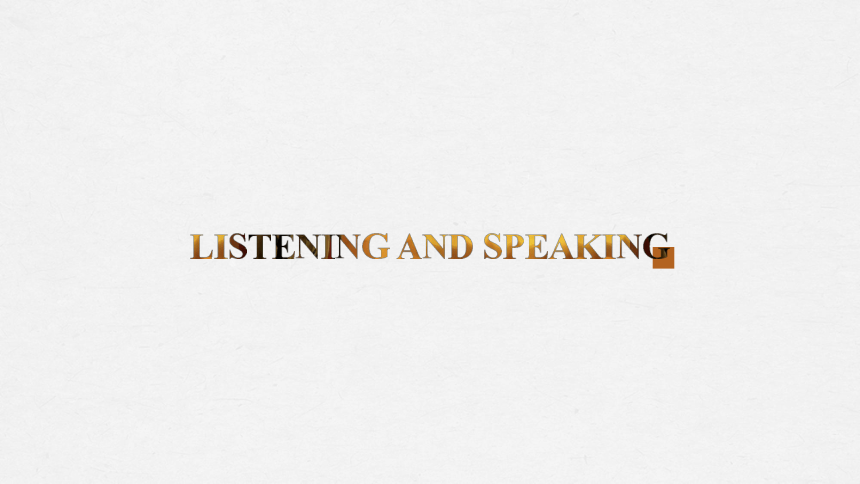


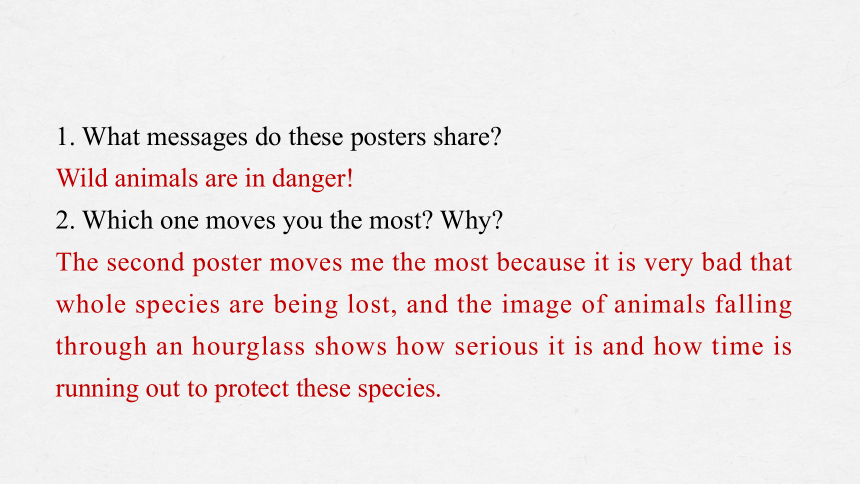

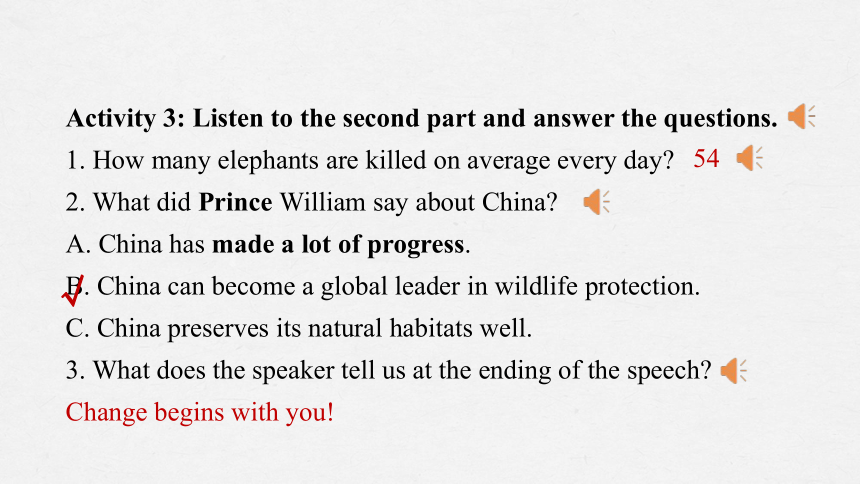

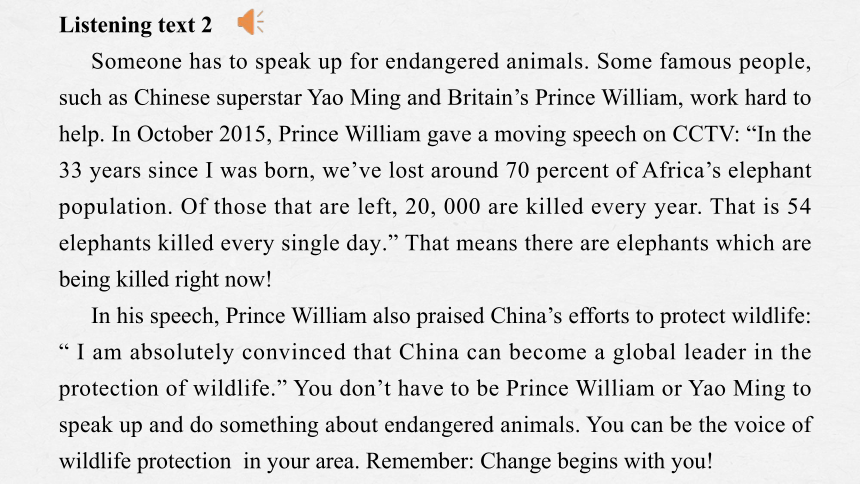

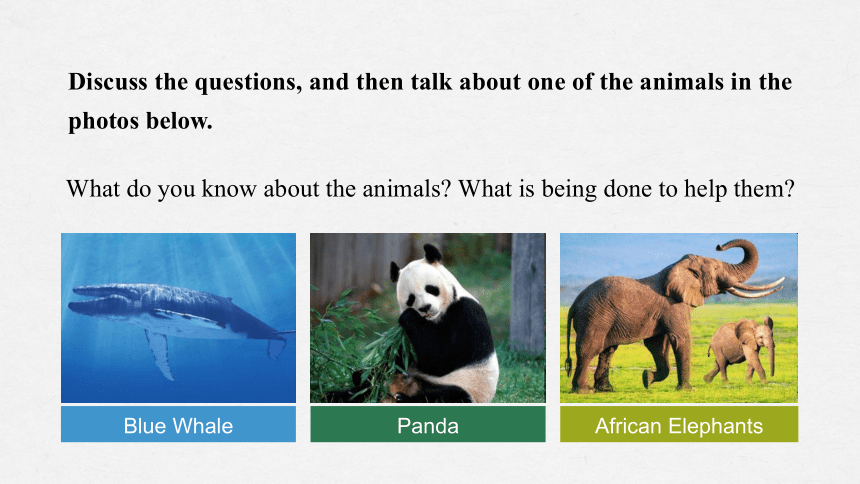
文档简介
(共31张PPT)
Listening and Speaking & Listening and Talking
Wildlife protection
Unit 2
By the end of this period, you will be able to:
1. learn to talk about saving endangered wildlife;
2. learn to use visuals to predict content;
3. learn to listen for general and specific information;
4. think about the problems the wildlife in your neighborhood may face and the solutions to them.
LISTENING AND SPEAKING
When the buying stops, the killing can too.
—WildAid
Enjoy a video
Activity 1: Before you listen, discuss these questions in pairs.
1. What message do these posters share
2. Which one moves you the most Why
Use visuals to predict content
Before you listen, look at pictures, charts, videos and other visuals to help you predict what you will hear.
1. What messages do these posters share
Wild animals are in danger!
2. Which one moves you the most Why
The second poster moves me the most because it is very bad that whole species are being lost, and the image of animals falling through an hourglass shows how serious it is and how time is running out to protect these species.
Activity 2: Listen to the first part and fill in the blanks.
What on Earth Are We Doing to Our Planet
Our planet’s ________ is dying out at an alarming rate. Between 150-200 species are becoming extinct every day. This mass extinction is caused by hunting, habitat ______, and pollution. We must make people aware of the problem and help _______ the endangered wildlife before it’s too late!
a measurement of the speed at which sth happens
a large number of; huge; serious
natural environment where animals live and grow
death of all its living members
loss
wildlife
protect
Activity 3: Listen to the second part and answer the questions.
1. How many elephants are killed on average every day
2. What did Prince William say about China
A. China has made a lot of progress.
B. China can become a global leader in wildlife protection.
C. China preserves its natural habitats well.
3. What does the speaker tell us at the ending of the speech
Change begins with you!
54
√
A: Have you seen that poster with the clock It's so good, but a little scary, too.
B: I know. So many wild animals are dying out. This poster says that between 150 and 200 species die out every day.
A: That' s terrible. We really need to do something. Why are so many species dying
B: Well, some animals are being hunted and killed. And then there’s pollution and habitat loss, I guess. Animals need a place to live in, just like us, and they need clean air and water, too.
A: It seems like people need to be more aware.
B: Absolutely. More people need to know.
A: Yes, they should make more of these posters—maybe it will help protect the wildlife.
Listening text 1
Listening text 2
Someone has to speak up for endangered animals. Some famous people, such as Chinese superstar Yao Ming and Britain’s Prince William, work hard to help. In October 2015, Prince William gave a moving speech on CCTV: “In the 33 years since I was born, we’ve lost around 70 percent of Africa’s elephant population. Of those that are left, 20, 000 are killed every year. That is 54 elephants killed every single day.” That means there are elephants which are being killed right now!
In his speech, Prince William also praised China’s efforts to protect wildlife: “ I am absolutely convinced that China can become a global leader in the protection of wildlife.” You don’t have to be Prince William or Yao Ming to speak up and do something about endangered animals. You can be the voice of wildlife protection in your area. Remember: Change begins with you!
Discuss the questions: What does “Change begins with you” mean
If we want things to change, we must change ourselves first and not wait for others to change first. We must be the change we want to see in the world.
Discuss the questions, and then talk about one of the animals in the photos below.
Panda
African Elephants
What do you know about the animals What is being done to help them
Blue Whale
You can organize the information in this way:
A: I’m concerned about _____. What do you know about them
B: Well, I know that they’re being _______ and their habitat/number is ________, so they’re in danger of ______. They need _______(living space), so it’s difficult for them to adapt to the changes.
A: That’s terrible. What measures are being taken to help them
B: The authorities are under pressure to _______and tell people not to ______.
an animal
problems
measures
Possible version:
A: I’m concerned about the blue whales. What do you know about them
B: Well, I know that they’re being hunted and their number is getting dramatically smaller, so they’re in danger of extinction. Blue whales need large and clear water habitats, so it’s difficult for them to adapt to the changes.
A: That’s terrible. What measures are being taken to help them
B: The authorities are under pressure to make laws to ban illegal hunting whales and tell people not to buy whales products.
LISTENING AND TALKING
Have you heard about birdwatching How much do you know about it Let’s watch a video.
What tools are used when watching birds
Guess the meanings of the following word and phrases.
binoculars
bird feeder
bird field guide
TIPS
You can guess the new words’ meaning by analyzing the words’ formation.
binoculars
bird feeder
bird field guide
前缀“bi-” 意为“two”
指南
喂养
“-er” means “something or somebody that does something”
Activity 1: Match the words with pictures.
1. binoculars
2. bird feeder
3. bird field guide
A
B
C
B
A
C
What are the functions of the following things
It’s used to observe things from far away.
binoculars
It is used to give food to birds.
bird feeder
A bird field guide is a book designed to help readers identify birds.
Activity 2: Choose the right ending for each sentence.
1. Binoculars ______.
2. Build bird feeders ______.
3. Use a bird field guide ______.
4. Put paper cut-outs on windows ______.
A. in order to identify birds
B. so that birds do not crash into them
C. to make sure that birds have enough food
D. are used for watching birds from far away
A
B
C
D
Expressions used to express purposes
be used for…
in order to…/so as to…/to…
so that…/in order that…
+ n. / pron. / v-ing
+ verb
+ sentence
1. Who are the teenagers
2. Where are they
3. What are they doing
4. Why are they doing it
They’re from a birdwatching club.
In the Qinling Mountains.
They’re searching for new wild birds and looking them up in their field guide.
It’s interesting and you can practise it anywhere.
Activity 3: Listen and answer the questions.
Activity 4: Listen again and use the phrases you hear to fill in the blanks.
1. They got up early ________ search for wild birds.
2. I’ve bought a field guide ________ we can look up the birds we see.
3. My dad gave me the binoculars ____________ we can see the birds better.
4. Birdwatching clubs clean up habitats, build bird feeders, and put paper cut-outs on windows __________ protect birds.
so as to
so that
in order that
in order to
Listening text
Narrator: It’s 5:00 a.m. on a Saturday morning and some teenagers have gathered in the Qinling Mountains. They got up early so as to search for wild birds.
A: OK, is everybody ready Do you have all the equipment
B: I’ve brought a bird field guide so that we can look up the birds we see. It’s a really good field guide. It’s got descriptions of all the main types of birds, and even a CD with lots of birdsong.
C: Great! My dad gave me these binoculars in order that we can see the birds better. They’re really powerful.
A: Cool, so let’s go.
[Soft footsteps as they walk away.]
A: Shh ...Do you hear that
[Birdsong.]
B: I think that’s a ... Give me the binoculars!
C: What can you see
B: Yes, there it is! Wow, it’s a ...
[Fade out.]
Narrator: Birdwatching is an interesting hobby that you can do anywhere. The Qinling Mountains are one of the best birdwatching sites in China, but you can also find many species in your local park. Birdwatching clubs clean up habitats, build bird feeders, and put paper cut-outs on windows in order to protect birds.
Activity 5: Think of other wildlife in your neighbourhood and their needs. What can you do to care for them Discuss their needs and solutions in groups.
Tips
List the wildlife in your neighbourhood;
Think of the problems they are facing;
Think of ways to solve the problems. You can take the listening material for an example.
EXAMPLE
A: I often see wild cats in our neighbourhood. Maybe we should do something to care for them.
B: Should we put out bowls of food for them
C: Sure, and I think we could also put out boxes or other things for them, so that they can find shelter when it’s cold or wet outside.
Listening and Speaking & Listening and Talking
Wildlife protection
Unit 2
By the end of this period, you will be able to:
1. learn to talk about saving endangered wildlife;
2. learn to use visuals to predict content;
3. learn to listen for general and specific information;
4. think about the problems the wildlife in your neighborhood may face and the solutions to them.
LISTENING AND SPEAKING
When the buying stops, the killing can too.
—WildAid
Enjoy a video
Activity 1: Before you listen, discuss these questions in pairs.
1. What message do these posters share
2. Which one moves you the most Why
Use visuals to predict content
Before you listen, look at pictures, charts, videos and other visuals to help you predict what you will hear.
1. What messages do these posters share
Wild animals are in danger!
2. Which one moves you the most Why
The second poster moves me the most because it is very bad that whole species are being lost, and the image of animals falling through an hourglass shows how serious it is and how time is running out to protect these species.
Activity 2: Listen to the first part and fill in the blanks.
What on Earth Are We Doing to Our Planet
Our planet’s ________ is dying out at an alarming rate. Between 150-200 species are becoming extinct every day. This mass extinction is caused by hunting, habitat ______, and pollution. We must make people aware of the problem and help _______ the endangered wildlife before it’s too late!
a measurement of the speed at which sth happens
a large number of; huge; serious
natural environment where animals live and grow
death of all its living members
loss
wildlife
protect
Activity 3: Listen to the second part and answer the questions.
1. How many elephants are killed on average every day
2. What did Prince William say about China
A. China has made a lot of progress.
B. China can become a global leader in wildlife protection.
C. China preserves its natural habitats well.
3. What does the speaker tell us at the ending of the speech
Change begins with you!
54
√
A: Have you seen that poster with the clock It's so good, but a little scary, too.
B: I know. So many wild animals are dying out. This poster says that between 150 and 200 species die out every day.
A: That' s terrible. We really need to do something. Why are so many species dying
B: Well, some animals are being hunted and killed. And then there’s pollution and habitat loss, I guess. Animals need a place to live in, just like us, and they need clean air and water, too.
A: It seems like people need to be more aware.
B: Absolutely. More people need to know.
A: Yes, they should make more of these posters—maybe it will help protect the wildlife.
Listening text 1
Listening text 2
Someone has to speak up for endangered animals. Some famous people, such as Chinese superstar Yao Ming and Britain’s Prince William, work hard to help. In October 2015, Prince William gave a moving speech on CCTV: “In the 33 years since I was born, we’ve lost around 70 percent of Africa’s elephant population. Of those that are left, 20, 000 are killed every year. That is 54 elephants killed every single day.” That means there are elephants which are being killed right now!
In his speech, Prince William also praised China’s efforts to protect wildlife: “ I am absolutely convinced that China can become a global leader in the protection of wildlife.” You don’t have to be Prince William or Yao Ming to speak up and do something about endangered animals. You can be the voice of wildlife protection in your area. Remember: Change begins with you!
Discuss the questions: What does “Change begins with you” mean
If we want things to change, we must change ourselves first and not wait for others to change first. We must be the change we want to see in the world.
Discuss the questions, and then talk about one of the animals in the photos below.
Panda
African Elephants
What do you know about the animals What is being done to help them
Blue Whale
You can organize the information in this way:
A: I’m concerned about _____. What do you know about them
B: Well, I know that they’re being _______ and their habitat/number is ________, so they’re in danger of ______. They need _______(living space), so it’s difficult for them to adapt to the changes.
A: That’s terrible. What measures are being taken to help them
B: The authorities are under pressure to _______and tell people not to ______.
an animal
problems
measures
Possible version:
A: I’m concerned about the blue whales. What do you know about them
B: Well, I know that they’re being hunted and their number is getting dramatically smaller, so they’re in danger of extinction. Blue whales need large and clear water habitats, so it’s difficult for them to adapt to the changes.
A: That’s terrible. What measures are being taken to help them
B: The authorities are under pressure to make laws to ban illegal hunting whales and tell people not to buy whales products.
LISTENING AND TALKING
Have you heard about birdwatching How much do you know about it Let’s watch a video.
What tools are used when watching birds
Guess the meanings of the following word and phrases.
binoculars
bird feeder
bird field guide
TIPS
You can guess the new words’ meaning by analyzing the words’ formation.
binoculars
bird feeder
bird field guide
前缀“bi-” 意为“two”
指南
喂养
“-er” means “something or somebody that does something”
Activity 1: Match the words with pictures.
1. binoculars
2. bird feeder
3. bird field guide
A
B
C
B
A
C
What are the functions of the following things
It’s used to observe things from far away.
binoculars
It is used to give food to birds.
bird feeder
A bird field guide is a book designed to help readers identify birds.
Activity 2: Choose the right ending for each sentence.
1. Binoculars ______.
2. Build bird feeders ______.
3. Use a bird field guide ______.
4. Put paper cut-outs on windows ______.
A. in order to identify birds
B. so that birds do not crash into them
C. to make sure that birds have enough food
D. are used for watching birds from far away
A
B
C
D
Expressions used to express purposes
be used for…
in order to…/so as to…/to…
so that…/in order that…
+ n. / pron. / v-ing
+ verb
+ sentence
1. Who are the teenagers
2. Where are they
3. What are they doing
4. Why are they doing it
They’re from a birdwatching club.
In the Qinling Mountains.
They’re searching for new wild birds and looking them up in their field guide.
It’s interesting and you can practise it anywhere.
Activity 3: Listen and answer the questions.
Activity 4: Listen again and use the phrases you hear to fill in the blanks.
1. They got up early ________ search for wild birds.
2. I’ve bought a field guide ________ we can look up the birds we see.
3. My dad gave me the binoculars ____________ we can see the birds better.
4. Birdwatching clubs clean up habitats, build bird feeders, and put paper cut-outs on windows __________ protect birds.
so as to
so that
in order that
in order to
Listening text
Narrator: It’s 5:00 a.m. on a Saturday morning and some teenagers have gathered in the Qinling Mountains. They got up early so as to search for wild birds.
A: OK, is everybody ready Do you have all the equipment
B: I’ve brought a bird field guide so that we can look up the birds we see. It’s a really good field guide. It’s got descriptions of all the main types of birds, and even a CD with lots of birdsong.
C: Great! My dad gave me these binoculars in order that we can see the birds better. They’re really powerful.
A: Cool, so let’s go.
[Soft footsteps as they walk away.]
A: Shh ...Do you hear that
[Birdsong.]
B: I think that’s a ... Give me the binoculars!
C: What can you see
B: Yes, there it is! Wow, it’s a ...
[Fade out.]
Narrator: Birdwatching is an interesting hobby that you can do anywhere. The Qinling Mountains are one of the best birdwatching sites in China, but you can also find many species in your local park. Birdwatching clubs clean up habitats, build bird feeders, and put paper cut-outs on windows in order to protect birds.
Activity 5: Think of other wildlife in your neighbourhood and their needs. What can you do to care for them Discuss their needs and solutions in groups.
Tips
List the wildlife in your neighbourhood;
Think of the problems they are facing;
Think of ways to solve the problems. You can take the listening material for an example.
EXAMPLE
A: I often see wild cats in our neighbourhood. Maybe we should do something to care for them.
B: Should we put out bowls of food for them
C: Sure, and I think we could also put out boxes or other things for them, so that they can find shelter when it’s cold or wet outside.
